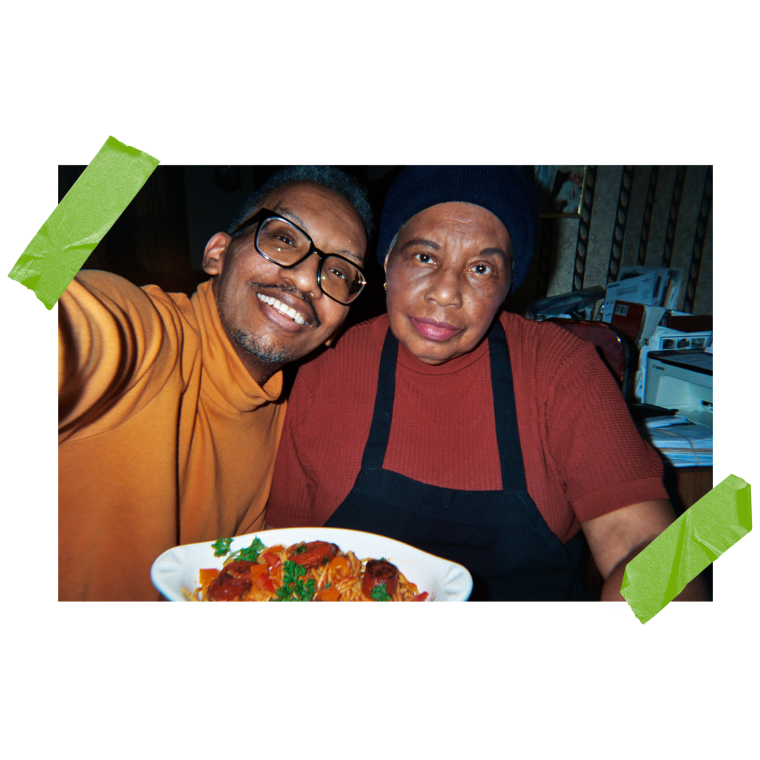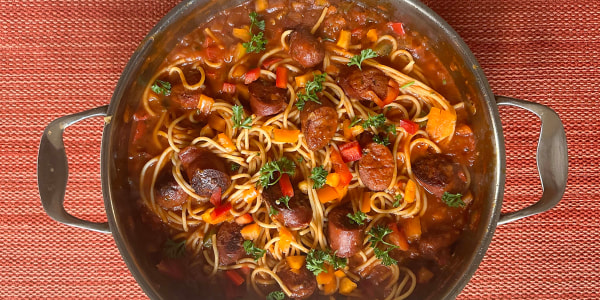I wasn’t exactly a chicken nugget child, but I was always nervous about how the Haitian food I ate at home was different from what my classmates would bring for lunch. So, in an effort to fit in as a child of immigrant parents, I turned into a judgmental jerk when it came to the food of my own people.
My folks would mix pizza night and fried chicken with the food of our people: poul non sos (chicken in sauce), soup joumou and the culinary underdog — espageti (Haitian spaghetti) — a dish that connects the dots of my family history, from America to Haiti and back again.
But that didn’t matter to me at the time. I wondered why the dish didn’t have meatballs like a can of SpaghettiOs did.
Espageti features spaghetti tossed in a combination of tomato sauce or ketchup, sausage or hot dogs, and epis, the garlicky, oniony and sometimes spicy seasoning base used in most Haitian dishes.
My young self thought this spaghetti, with its roots in several cuisines, was some strange riff my mom had made up herself. I didn’t even know it had a name. But its history is much more rich than my adolescent myopia could even imagine.

Where did Haitian spaghetti, aka espageti, come from?
From its name, espageti may sound like it made a beeline from Italy to Haiti, but it actually made a stop in the United States first.
“The history of espageti has more to do with U.S. occupation than it did with Italian acculturation,” Brigid Washington, journalist, educator and author of “Caribbean Flavors for Every Season,” tells me.
It’s widely believed that the origins of espageti occurred in the decades after a tumultuous century for Haiti. After the Haitian people gained independence on Jan. 1, 1804, stability proved elusive for the nearly 500,000 formerly enslaved, free Black people and white folks remaining.
In July 1915, Haitian President Vilbrun Guillaume Sam was assassinated, marking the seventh time in seven years Haiti was left without a president. From 1903 to 1915, at least six presidents were overthrown. Sam wasn’t even the first to be assassinated, and more than a few of his predecessors died under mysterious circumstances or confirmed fatal coups.
With this in mind, countries like Germany had their sights set on controlling Haiti. For America, the possibility of Germany gaining control of the island nation located so close to Florida was too risky, so President Woodrow Wilson decided to invade and occupy Haiti. This occupation lasted almost two decades, until 1934.
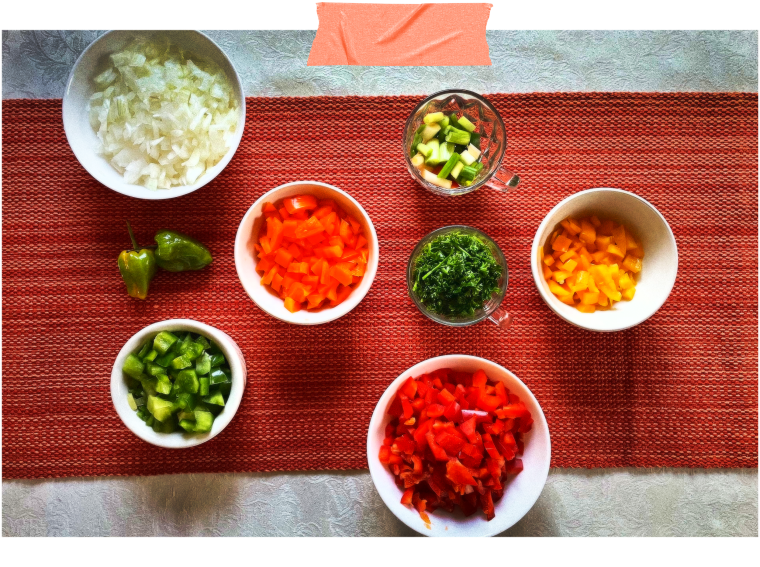
In addition to the U.S. controlling the government and finances of Haiti, the Haitian-American Treaty of 1915 created a military force made up of Americans and Haitians controlled by the Marines. This influx of Americans were now living — and therefore eating — among the Haitian people.
It’s well-known that military occupation is responsible for many foods leaping from one culture to another, creating new versions of staple dishes in the process. British curry comes from Britain’s occupation of India, Spam has become integral to Hawaiian cuisine because of U.S. troops stationed there during World War II, and the banh mi sandwich is a result of France colonizing the country, bringing its crusty bread along for the ride.
By the early 20th century, most Americans were regularly incorporating pasta into meals for the family, so it stands to reason that those troops introduced the popular tastes of home — hot dogs, ketchup and spaghetti — to my very ancestors, who placed those into espageti, historically enjoyed as a breakfast dish.
“When we’re talking about immigrants like during the Haitian Revolution or in the middle of fighting and tours of war, nobody is writing anything down,” Washington says.
It’s true: There’s a lot of guesswork involved in tracking the history of a formerly enslaved population that, for centuries, was only given portions of the Bible that omitted Moses leading the Israelites to freedom, among other passages.
Learning to appreciate espageti and its legacy
Washington notes that espageti is a daily comfort food that has not yet risen to culinary icon status like other Haitian dishes such as cremas (a creamy, rum-based holiday drink) or griot (fried pork) have.
But it is a dish that has been sold by vendors on the streets of Haiti for decades and served as a source of comfort after the 2010 earthquake, so it deserves its own praise.
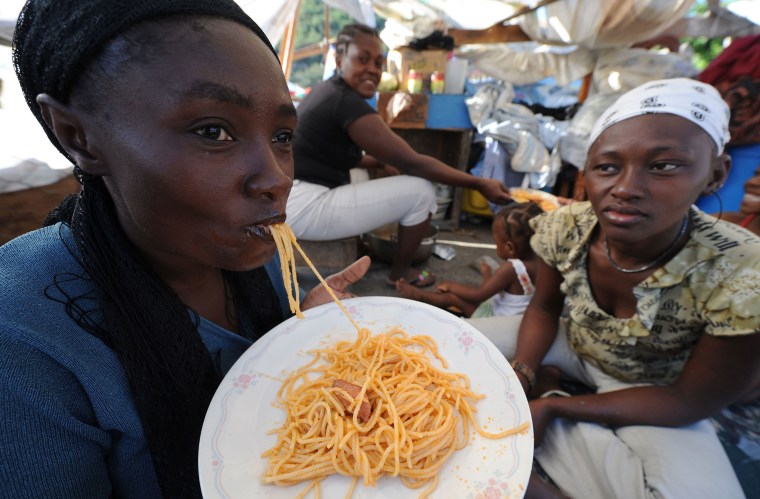
As a recovering teenage jerk now entering his 40s with new perspective, grace and openness, I think back to when I first realized that espageti — and by extension, my mother’s cooking — was something to be lauded.
While fully immersed in my musical theater era, I spent a hearty chunk of my junior year of high school rehearsing for our musical, “Little Shop of Horrors.” (I played Seymour.) During the long nights and weekends of rehearsing, we often relied on fast food to fuel us.
One Saturday, my mom made a huge pot of espageti to bring to rehearsal, because, as she said, she was sick of me “spending money on grease.” It was such a hit, I barely got a bite before my castmates from so many cultures tore apart that pot of Haitian history until there was nary a noodle left. My mom was a hero that day.
“It’s affordable, adoptable, approachable,” says Washington, describing the dish’s appeal. She points to other dishes in the Caribbean, like beans and rice and saltfish, that similarly show that “simple, flavorful and filling” are the keys to feeding people who need sustenance.
“(Espageti’s) legacy, it’s easy to miss, but it should not be mocked. When I make my food from Trinidad and my kids are screwing up their faces, I get so mad at them,” Washington says. “I’m like, ‘You have no idea. I know, yes, you’re stubborn and you want some Chick-fil-A. This is who you are. This is a part of me. And it’s a part of you and your story.’”
Making espageti with Mom
I recently made the dish with my mom to record her recipe, since she’d never written it down before.
She taught me how she makes her own preferred epis, with parsley, garlic and a bit of lime. It’s something I’ve never actually done before, and now a whole new world of Haitian cuisine has opened up for me.
America had an influence on Haitian food, and so did American cooking styles on my mother: Gone are the mortar and pestle she used to use in my youth, when the drum beat of her pounding epis spoke a rhythm noting dinner was on its way.
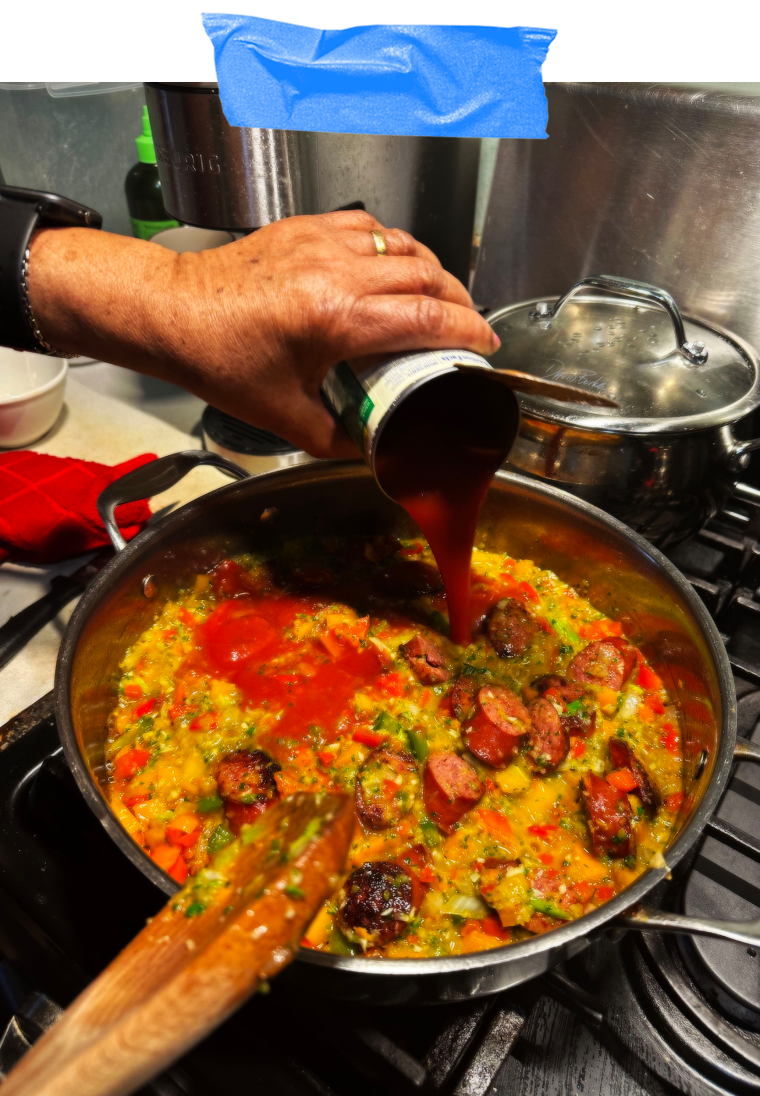
“Use the food processor,” my mom told me as we chopped bell pepper, onion, scallions and parsley into chunks for eventual blending. As my mom put the pasta in the boiling water, I sliced the kielbasa and marveled at how quick the epis came together.
After sauteing some extra vegetables with a scoop of the epis and the tomato sauce, my mom and I finished the meal with its various components: red, orange, yellow and green peppers, spaghetti, sauce, sausage and some fresh parsley on top. To me, it looked like a plate of confetti — a celebration of our history.
As we ate, my mom told me that Haitian food is easy to make when you know what you’re doing.
And now I know what I’m doing.
